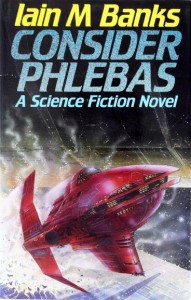Consider Phlebas





Consider Phlebas
by Iain Banks
Republished by Orbit, 2008
On Amazon
***
When I think of the best science fiction, I never think of it as actual science fiction. Rather, tales of humanity revealing glimpses into its nature that would otherwise be difficult to convey without the facade of artificial quasars and exotic aliens. “Iain Banks has ruined most sci-fi for me,” said a friend who was recommending the Culture series to me. With the recent news that Iain Banks was suffering from a terminal cancer to his gallbladder, I felt it was time to dive into this long and branching series I’d been hearing about for so long. I started with the first book, Consider Phlebas, which on the surface is a space opera with swash buckling action. It’s set to the backdrop of a war that is taking place between the Culture and the religiously fanatical civilization called the Idirans. The machines of the Culture are more complex than humans and have unique personalities that help calculate/determine their future. When the Mind of a brand new Culture ship escapes into a Planet of the Dead, the two factions race to retrieve it. The protagonist is Horza, a shape-changer sent by the Idirans because he has special access to the planet that the others do not.
The title, Consider Phlebas, comes from T.S. Eliot’s The Waste Land and like The Waste Land, there are mixes of satire and futurism in the chapters that balance fantastic elements with descriptions that make it easy for a reader to envision. Take for example, the description of an Orbital (an artificial planet/ring world) being destroyed by the Culture as a result of the war: “…a single narrow line of blinding white light appeared right across the breadth of the day side of the Orbital, a thin fiery blade of silent destruction which was instantly surrounded by the duller but still perfectly white cover of clouds. That line of light was part of the grid itself, the fabric of pure energy which lay underneath the entire universe, separating this one from the slightly younger, slightly smaller antimatter universe beneath… The Orbital was now a rosette of white flat squares backing slowly away from each other toward the stars: four hundred separate slabs of quickly freezing water, silt, land and base material, angling out above or underneath the plane of the system’s planets like flat square worlds themselves. There was a moment of grace then, as Vavatch died in solitary blazing splendor.” I could see Vavatch’s last moments in my head and marveled at the creative way Banks depicted the scene. There are many such moments and the imagery has a palpable intensity to it.
July 1st, 2013 / 11:00 am
